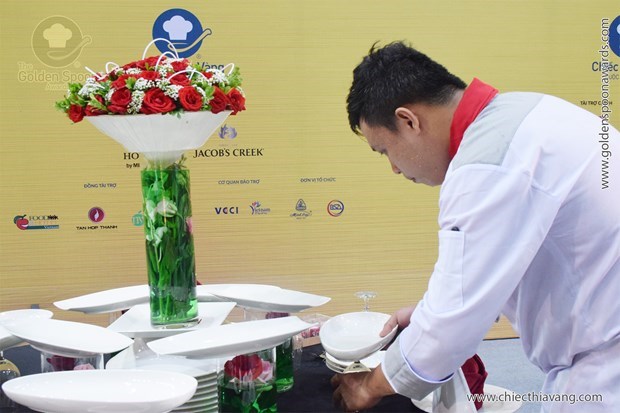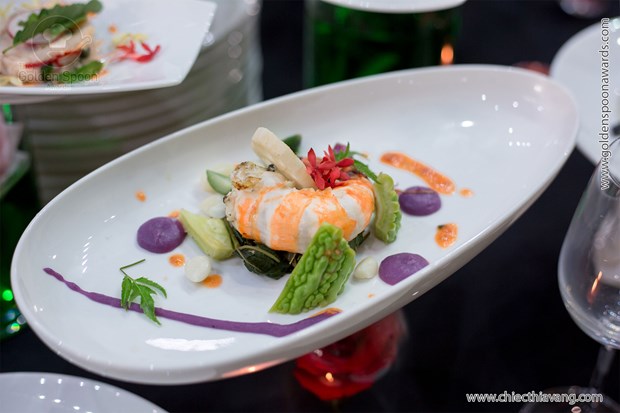140 minutes… of fear
Arriving at Tien Son Sports Hall,
teams of North Central Coast regions had quickly gathered necessary ingredients
before the cooking session started as well as brought the banquet table display
into group discussion. Among all hustle and bustle of the surroundings, a young
chef was calmly concentrating on his team’s table presentation. That chef is
Phan Duy Quy – leader of Team no. 63 from Grand Sunrise Hotel Da Nang.
People usually recognize him for his
tall, brawny shape and sweats streaming continuously from his face; which drew him
even more attention from the crowd in the cooking session. During 140 minutes,
Quy and his team briskly carried out the intended menu within the time
allotted. His moves were sharp, showing the professionalism and desire to win.
He seemingly involved in every stage from processing, cooking, seasoning, garnishing
to displaying on the table.

Chef Phan Duy Quy is prepping for his team’s table display.
During the competition day, Quy
didn’t seem to take a break. The chef, born 1993, rushed back and forth from
the cooking station to the oven, from the display table back to the cooking
station. His energy was greatly applauded by spectators, among who are his
students from Netspace School of Culinary Arts. Quy did well until the last
minute. When the time was up, he dropped his tools in relief. The chef
profusely perspired after a 140-minute marathon in the cooking station.
In a brief interview after the cooking
session, Quy said, “This is the first time I competed in the Golden Spoon
Awards, so I do not have much experience. I also would want to showcase various
types of spice and herbs that I myself found, however, there was not enough
time. Luckily, I finished everything just in time. In the end, things went
pretty well thanks to my team’s support including my girlfriend’s”.
Taste quest in Hon Tau
Articulating fluently while
hurriedly finalizing the menu, Quy told us the story of his team’s journey to
find new spices. “In order to create our own menu, I spent a lot of thought.
Coming from the theme Hometown flavor in
the age of global integration, I decided to introduce specialties of Que
Son – my maternal hometown. The place is famous for different types of spice
and inexpensive ingredients that not many people have heard of. It is also
where I lived most of my childhood”, said he.
Unhesitant, Quy and his teammates
started a “pilgrim” to the forest of Hon Tau, a mountainous area forming the
provincial border between Duy Xuyen, Nong Son and Que Son of Quang Nam with the
area of nearly 100 sq. km consisting of rugged cliffs of Nha Muoi, Cu Hang, Mat
Rang and multiple large caves. Hon Tau is known for being the military base of
revolutionary forces during the final years of Resistance War Against America.
The journey in search of spices lasted
two days one night. “Although we already have some spices in hand to use, we
still embark this trip in hope of building a more colorful and diverse menu.
This is the first trekking trip we have made, hence, were quite inexperienced.
Day one, everything went on well until the sun came down. We didn’t bring
enough food; and it began to rain so heavily that we could not either retreat
or move forward. We decided to camp there one night. The morning after that, on
the way down, we fortunately met a local who showed us where to find the wild leaves
such as shiny-leaf prickly-ash, peperomia, gamboge, bush okra, pandan, ixora, moringa,
etc.”.
The men brought all the leaves they
found from the trip to the prelim, incorporating them with Quang Nam’s produce
to create an impressive menu. Besides the seafood, meat and dessert courses,
they cooked three different entrées which includes: Spurdog salad with tamarind leaf and chay fruit fish paste – Yam bean
noodle rolled salad and Cau Mong veal with Tra Que herbs – Three-layer seafood
roll – Hot stoned giant river prawn with Hong Dao wine, A Mot pepper, smashed
purple sweet potato, pandan leaf and assorted greens salad; Deo Le chicken and
wild star fruit vine served with Que Son yam bean noodle; Que Son sweet potato
served with moringa nitrogen ice cream.
Quy said, “The menu I created follow
our intinerary in search for wild moringa at the foot, star fruit vine in the
middle, pandan leaf, gamboge, shiny-leaf prickly-ash, bush okra on the flank
and tamarind leaf on the top of the mountain. Our banquet table is also
arranged in this way”.

The banquet table is inspired by the journey to Hon Tau of Team no. 63. At the bottom – foot of the mountain – is Que Son sweet potato served with moringa nitrogen ice cream; the middle Deo Le chicken and wild star fruit vine served with Que Son yam bean noodle; the peak spurdog salad with tamarind leaf and chay fruit fish paste– Yam bean noodle rolled salad and Cau Mong veal with Tra Que herbs – Three-layer seafood roll.
Bring local produces to a new level
Not only leaving audience and the
judge panel with admiration for the aforementioned journey, the menu also
introduced various local produces such as Cau Mong veal, Tra Que herbs, Non
Nuoc stones, Hong Dao wine, A Mot pepper, Que Son sweet potato and yam bean
noodle. Team no. 63 brought along new tastes for the dishes by exploring and
improvising in the ways to process ingredients.
Quy was not hesitant to mix all
leaves and wild flowers found into a unique, tasty leafy salad which was served
with giant river prawn steamed using Non Nuoc hot stones and Hong Dao wine, and
A Mot pepper, smashed purple sweet potato with pandan leaf.
The young teacher of Western kitchen
shared, “This is the first time I made this kind of salad. It is an experiment
that crossed my mind after the trip. The salad includes gamboge which gives
fresh acidity, peperomia that tastes slightly sour, shiny-leaf prickly-ash that
provides minty and citrus flavors, moringa that possesses great health benefits
and bush okra which has umami taste. All of them create a mixture of sweet-sour
flavor and aroma which enhance the distinct taste of giant river prawn.

Hot stoned giant river prawn with Hong Dao wine, A Mot pepper, smashed purple sweet potato, pandan leaf and assorted greens salad received a lot of compliments from the judge panel.
One more special thing about this
dish is the giant river prawn cooked with Non Nuoc hot stones. Quy told us he
used lava stones from Non Nuoc mountain. The advantage of cooking food using
hot stones is that the dish can reserve its healthy nutrients, the meat will be
cooked through but still better remains juiciness and meaty sweetness than
normal grilling methods.
Judge Vu Kim Anh – former Deputy
Director, Ho Chi Minh City Department of Culture, Sports and Tourism, commented
on the menu, “I was impressed by your team’s performance. Especially, I really
like A Mot pepper from the forest of Tay Giang that you adopted in your
recipes. It is a special condiment that Co Tu ethnic community prefers.
Besides, you make good use of Vietnamese local spices into your dishes, which
helps elevates their tastes to a whole new level. However, the spurdog salad
with tamarind leaf and chay fruit fish paste is too sour for me”.
After the competition, his team was
one of eight second place finishes and qualified for the final round. When
asked about his future plan, Quy said, “During the prelim, I had a mild success
introducing local specialties of my maternal hometown, Que Son. In order to
prepare for the coming final round, I intend to showcase those from Thang Binh,
my paternal land. Though that could make or break our team’s performance, our
ultimate purpose is to learn and introduce delicious fare to promote our local
cuisine”.
By Cong Minh - Phuong
Tram